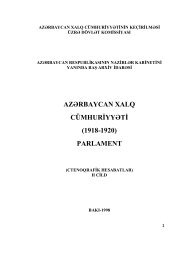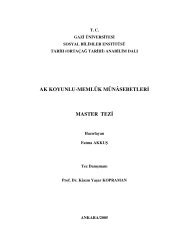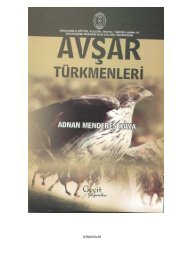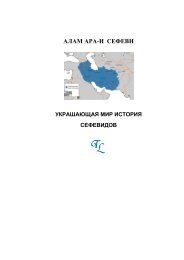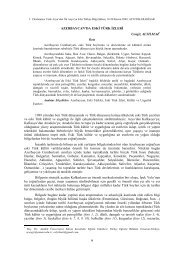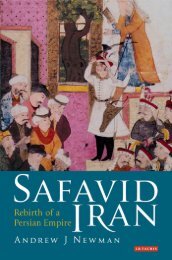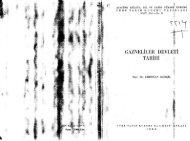War and Peace in Qajar Persia: Implications Past and ... - Oguzlar.az
War and Peace in Qajar Persia: Implications Past and ... - Oguzlar.az
War and Peace in Qajar Persia: Implications Past and ... - Oguzlar.az
- No tags were found...
Create successful ePaper yourself
Turn your PDF publications into a flip-book with our unique Google optimized e-Paper software.
54 Stephanie Cron<strong>in</strong>pr<strong>in</strong>cipally on his cavalry, the new <strong>in</strong>fantry regiments play<strong>in</strong>g little part <strong>in</strong>fight<strong>in</strong>g his wars. Nader Shah’s army collapsed after his death <strong>and</strong> by the lateeighteenth century none of the several Iranian experiments with Europeanmethods had achieved any endur<strong>in</strong>g effect.The first <strong>Qajar</strong> ruler, Agha Mohammad Khan, with the military forceshe was able to muster, successfully established <strong>Qajar</strong> power throughout Iran<strong>and</strong> temporarily drove the forces of the advanc<strong>in</strong>g Russian empire back beyondTiblisi, reassert<strong>in</strong>g Iranian supremacy over the k<strong>in</strong>gdom of Georgia. On hisaccession <strong>in</strong> 1797 Fath-Ali Shah was also able to comm<strong>and</strong> sufficient militarystrength to defeat his <strong>in</strong>ternal rivals <strong>and</strong> secure his position as shah.However <strong>in</strong> 1803 Russia <strong>in</strong>vaded <strong>and</strong> annexed Georgia, considered by Iranas a vassal state, <strong>and</strong> cont<strong>in</strong>ued to push southwards. Russia’s <strong>in</strong>exorable pressureforced Fath-Ali Shah (1797–1834) <strong>and</strong> especially his son, the crown pr<strong>in</strong>ce<strong>and</strong> governor of Azerbaijan, Abbas Mirza, to embark on a major militaryreorganization <strong>in</strong> the hope of <strong>in</strong>creas<strong>in</strong>g Iran’s defensive capacity. 16 AbbasMirza’s <strong>in</strong>itiative was the first <strong>in</strong> a long series of attempts by <strong>Qajar</strong> rulers toset up a st<strong>and</strong><strong>in</strong>g army on the European model with the help of missions offoreign officers. 17Fath-Ali Shah <strong>and</strong> Abbas Mirza made the first systematic attempt <strong>in</strong> Iranat military reform along modern European l<strong>in</strong>es, the political context be<strong>in</strong>gprovided by the first Russo-Iranian war (1804–1813). 18 Both the shah <strong>and</strong>his son were conv<strong>in</strong>ced that the <strong>in</strong>troduction of regiments of European-styletroops would enable them to break the deadlock <strong>in</strong> the war with Russia<strong>and</strong> w<strong>in</strong> victory, rega<strong>in</strong><strong>in</strong>g lost territory <strong>in</strong> the Caucasus <strong>and</strong> thus help<strong>in</strong>g tolegitimize their dynasty. In the early n<strong>in</strong>eteenth century the prov<strong>in</strong>ce ofAzerbaijan <strong>and</strong> its capital, Tabriz, constituted the front l<strong>in</strong>e aga<strong>in</strong>st Russianexpansion, <strong>and</strong> was the focus of Iran’s military efforts. Its military conditionwas also important for another reason. Tabriz was, by tradition, theseat of the crown pr<strong>in</strong>ce, <strong>and</strong> it was essential that the heir apparent possesssufficient armed strength to impose acceptance of his claim to the throne aga<strong>in</strong>stthe <strong>in</strong>evitable challenges on the death of the shah.Abbas Mirza, like his contemporaries <strong>in</strong> the Middle East <strong>and</strong> NorthAfrica, had come to the conclusion that the survival of both his dynasty <strong>and</strong>his country depended on match<strong>in</strong>g European military strength by imitat<strong>in</strong>gEuropean military organization. 19 Abbas Mirza seems to have been fasc<strong>in</strong>atedby European military science <strong>and</strong> James Morier quoted him as say<strong>in</strong>g thathe believed it was <strong>in</strong> va<strong>in</strong> to fight the Russians without soldiers like theirs,<strong>and</strong> that their artillery could only be opposed by artillery. 20 Deeply impressedby the steps already taken on this path by the Ottoman Empire under SultanSelim III, Abbas Mirza began the construction <strong>in</strong> Azerbaijan of his ownversion of the discipl<strong>in</strong>ed <strong>in</strong>fantry <strong>and</strong> artillery regiments known <strong>in</strong> the OttomanEmpire as the nezam-e jadid. Like Sultan Selim <strong>and</strong> his successors, Abbas Mirzaalso <strong>in</strong>tended that a Europeanized army would reduce <strong>and</strong> f<strong>in</strong>ally elim<strong>in</strong>atehis dependence on tribal <strong>and</strong> prov<strong>in</strong>cial chiefs <strong>and</strong> notables for the rais<strong>in</strong>gof military forces.



